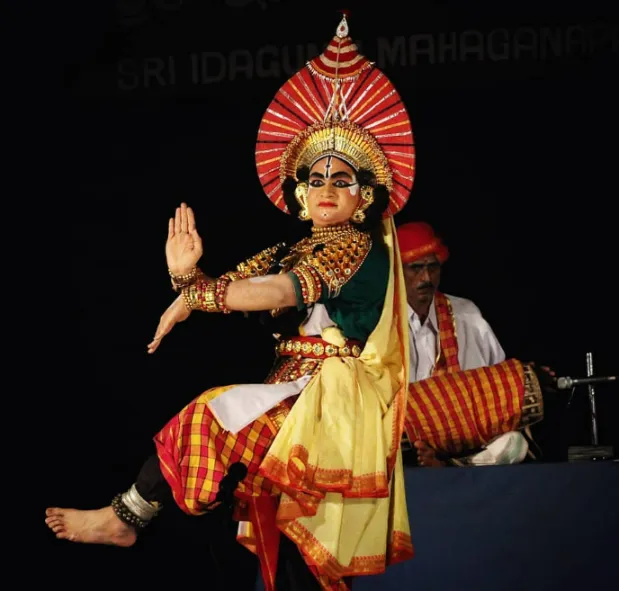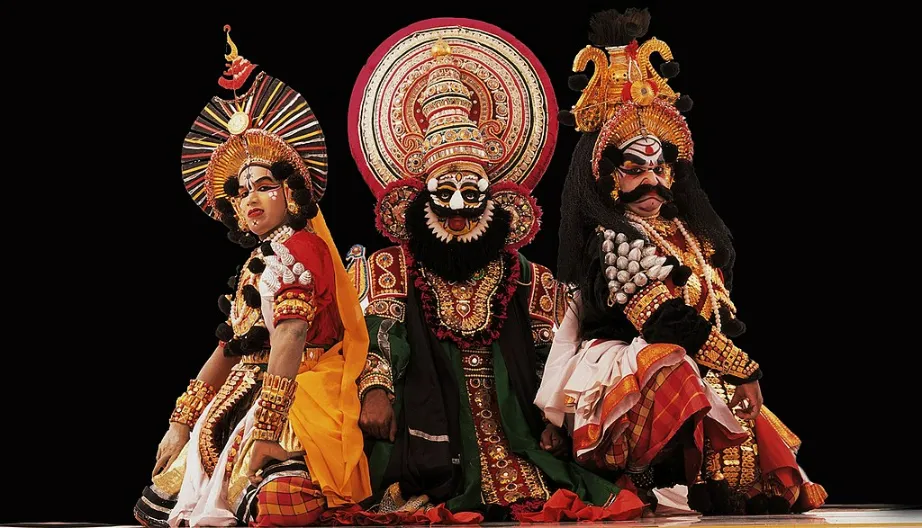YAKSHAGANA
Yakshagana, a traditional dance-drama, originates from South India and is closely linked with Karnataka, especially in its coastal districts. Additionally, it has gained popularity in the Kasaragod district of Kerala.
This art form, deeply rooted in temples, narrates mythological tales and Puranic stories. Yakshagana performances are characterized by intricate facial makeup, colorful costumes adorned with ornaments, and imposing headpieces. Its name stems from the combination of "Yaksha" (celestial) and "Gana" (music).
Believed to have emerged from pre-classical musical forms and theatrical arts, Yakshagana is a spectacle traditionally conducted in outdoor settings. It's presented by all-male troupes, often sponsored by different Hindu temples.

3. Elements of Yakshagana
The Performance
In Yakshagana, each show typically revolves around a specific sub-story, referred to as 'Prasanga,' extracted from the ancient Hindu epics like the Ramayana or Mahabharata. The presentation involves stage performances by skilled artists and a narrative commentary delivered by the lead singer, known as the Bhagavatha, accompanied by traditional music.
Understanding the Bhagavatha:
Part of the himmela, the Bhagavatha serves as the primary vocalist, narrating the tale through songs. Meanwhile, the dancers/actors, known as the mummela, enact stories derived from the Ramayana, Mahabharata, and the Puranas. The Bhagavatha assumes the role of the chief storyteller and employs a unique, enchanting high-pitched voice, invoking the Gods for a successful performance.
The Musical Aspect:
Yakshagana incorporates various musical instruments like the chande (drums), harmonium, maddale, taala (mini metal clappers), and flute, among others, contributing to the auditory richness of the performance.
The Attire:
The costumes in Yakshagana are distinctive and intricate, featuring large headgear, painted faces, elaborate body costumes, and musical bead adornments known as Gejje. Performers also wear Kavacha on the chest, armlets on the shoulders, and belts made of lightweight wood coated with golden foil. Given the weight of the costumes, performers require considerable physical strength, along with robust vocal and performance skills to sustain the act for extended durations.
Language and Troupes:
Yakshagana is predominantly presented in Kannada, although performances occasionally occur in Malayalam and Tulu. Throughout the year, several prominent troupes, known as Melas, engage in Yakshagana performances. Renowned Melas include Saligrama, Dharmasthala, Mandarthi, and Perduru.
3.1.Bagavatha
In Yakshagana, the Bhagavatha is a pivotal figure in the performance. Part of the himmela (the musical ensemble), the Bhagavatha assumes the role of the lead singer and narrator. Their primary responsibility is to orally narrate and sing the stories, mythological tales, or episodes from epics like the Ramayana, Mahabharata, or Puranas. The Bhagavatha's narration, carried out through songs and storytelling, guides the performance and engages the audience, often invoking divine blessings for a successful and captivating show. Their enchanting and distinctive high-pitched singing style is a hallmark of Yakshagana performances, adding depth and emotion to the storytelling.
4. Variants of Yakshagana
- Moodalapaya: The eastern form, popular in north Karnataka
- Paduvalapaya: The western style, also known as coastal Yakshagana
- Thenku Thittu: The southern form
- Badagu Thittu: The northern form
- Nadu thittu
- Baada badagu thittu





